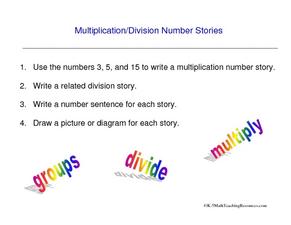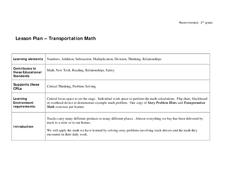Curated OER
Multiplication/Division Number Series
Expand mathematical thinking with these prompts for scholars to use writing as they approach math. First, they use the numbers 3, 5, and 15 in an original multiplication number story, followed by a related division story. Encourage...
Curated OER
Making Number Stories - Multiplication
In this number story worksheet, learners read the multiplication operation and then write a number story to go along with it. There are 3 problems on this page.
Curated OER
Making Number Stories: Multiplication
in this number story instructional activity, students write number stories about the multiplication equations and answers on the page. There are 2 problems on this instructional activity.
Curated OER
Making Number Stories - Multiplication
In this number story worksheet, students write number stories about the multiplication operations on the page. There are 2 questions on this worksheet.
Curated OER
Transportation Math
Students recognize math problems within stories. In this consumer math activity, students discover clues to solve math problems within written story problems. Students complete the story problems on a worksheet.
Curated OER
Summer Word Jumble
In this unscrambling the letters worksheet, students read the vocabulary words associated with summer in the word bank, unscramble them, and write them correctly. Students write 20 answers.
Curated OER
Free Printables: Alphabet Cards
For this alphabet worksheet, students cut out the alphabet cards, which have words and pictures to go along with each letter. This worksheet generator can print off 2 different sets of cards for the alphabet so that students can match up...
Curated OER
Where Do I Live?
Learners study the characteristics of communities. Students identify similarities and differences in communities. Learners identify that all people have basic needs, understanding that these needs are met through the community. Students...









